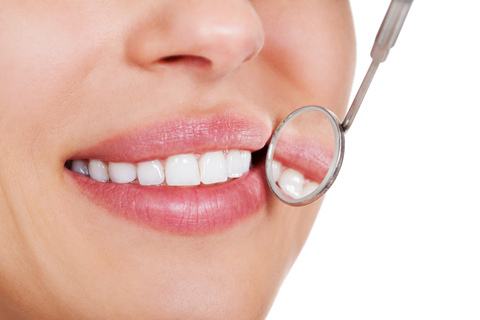Which whitening is right for you?
March 16th, 2022

Many of our patients at Dr. John Rottschalk Dental Group have been asking us about brightening their teeth lately, and today we thought we would discuss the options available to you to put the sparkle back in your smile!
Over-the-counter products – You’ve probably seen over-the-counter whiteners such as whitening strips on store shelves. While whitening strips may work for some, they do have certain restrictions. For example, they are not nearly as effective when crowns or fillings are involved. Teeth that are stained gray instead of brown or yellow typically don’t respond as well to these types of whiteners. Whitening strips typically save you money but take longer to work and also require discipline on your part to keep them in place for the right amount of time each day.
Whitening at our office – This type of whitening can be done right at Dr. John Rottschalk Dental Group. A whitening agent is applied directly to teeth and a special light helps accelerate the whitening process. This may be accomplished in one session or take several appointments. You should expect to spend anywhere from 30 to 60 minutes at each session. If you have a mix of natural teeth and fillings or crowns, Drs. Rottschalk, Acker, and Froidcoeur may recommend bonding or veneers on your natural teeth instead of regular bleaching. Teeth whitening at our office can be used to correct many tooth discolorations which may have been caused by staining, aging, or chemical damage to teeth. Using the latest in whitening technology, we can offer a safe method for creating the beautiful smile you've always wanted.
At-home whitening – If you choose this option, Drs. Rottschalk, Acker, and Froidcoeur will take a mold of your teeth and create a custom-fit whitening tray. Gel whitening solution is poured in the mouthguard-like tray, and the tray is worn for a pre-determined amount of time, generally from a couple of hours a day to every day during the night, until you’re back in our office for an evaluation.
Give us a call at our convenient Fairview Heights, IL office to schedule an appointment! Whiter teeth are one just one visit away at Dr. John Rottschalk Dental Group!
Is a Loose Tooth a Lost Tooth? Not Necessarily!
March 9th, 2022

When we were small, a loose tooth wasn’t a reason to be worried. On the contrary! It was a time to celebrate: A permanent tooth on the way. A sign that you were growing up. Perhaps even a lucrative visit from the Tooth Fairy. Losing a baby tooth had quite a few benefits.
Now that we’re grown, no such benefits are in store for us, because a lost adult tooth is gone for good. That’s why any time you notice a loose tooth you need to call Drs. Rottschalk, Acker, and Froidcoeur immediately. With prompt dental care, that tooth might be saved.
But first, a word about how our teeth stay firmly rooted in the jaw.
- The visible part (crown) of a tooth is protected by a layer of enamel. The root below is covered with a protective layer called cementum.
- There is a socket for each tooth in the alveolar bone of the jaw, where each root is firmly attached within the socket by the periodontal ligament which surrounds it.
- This ligament is made up of connective tissue, which attaches both to the cementum covering the root and to the alveolar bone. It not only holds the tooth in place, it cushions the tooth from the daily pressure of biting and chewing.
- The gums surround the teeth and bone, protecting them from bacteria.
If the tooth, bone, ligament, or gums suffer damage, the result can be a loose tooth.
Treating a Loose Tooth
The treatment you receive will depend on the reason your tooth is loose. There are many situations which can lead to a loose tooth or teeth, and many treatment options available to you. Some of the common causes and potential treatments include:
- Accident or Trauma
If you have suffered a tooth or jaw injury as a result of an accident or trauma, it’s very important to see your dentist or doctor immediately. You should be carefully examined to determine whether there is damage to other teeth or the jaw. Serious tooth or jaw bone injury might require treatment by an oral surgeon.
In some cases of damage to the periodontal ligament or tooth, even if your tooth is loose or extruded (partially out of its socket), it can be stabilized in place so that the ligament and tissue around it has time to heal.
We’ll make sure the root, nerves, and blood vessels are still intact, position the tooth back in its socket, and then anchor it to the adjacent teeth with a flexible splint for several weeks. In the case of an alveolar or a root fracture, a rigid splint may be used.
Splinting gives the periodontal ligament and bone surrounding it time to heal while keeping your injured tooth from further displacement.
- Bite problems & Bruxism
Your teeth are designed to withstand a lot of pressure—in fact, in some ways, pressure is essential for healthy teeth and bone. The normal pressure of chewing and biting stimulates bone tissue in the jaw. When a tooth is lost, that stimulation is gone and the result is gradual bone loss in the area underneath the lost tooth.
But sometimes, the pressure exerted by a malocclusion (bad bite) or bruxism (tooth grinding) is too forceful. The connective tissue which holds the teeth in place is damaged by these forces, and loose teeth can be the result.
If you have a serious malocclusion, an orthodontist can provide the relief you need with braces or aligners. If your bite problem is caused by a tooth or teeth which are a bit too high, the enamel can be carefully contoured and reshaped. In some cases, splints, either temporary or permanent, can also be used to stabilize several adjacent teeth so that any biting or chewing force is spread over the section as a whole.
If you grind your teeth, a night guard can be custom fitted to provide relief from the pressures and impact of tooth clenching and grinding. This special kind of mouth guard is known as an occlusal splint.
- Osteoporosis
Osteoporosis causes a loss of bone density throughout the body. Studies suggest that this disease can affect bone in the jaw, leading to weaker bone and looser teeth. Your physician will provide your best medical alternatives, and be sure to let us now if you are taking medication for osteoporosis before we plan your dental treatment.
- Periodontal Disease
Gum disease is one of the major causes of loose—and lost—teeth. Early gum disease, called gingivitis, should be treated promptly to avoid a more serious condition called periodontitis. Periodontitis can cause the gums to pull away from the teeth, creating pockets for bacterial growth and infection. Left untreated, this infection results in connective tissue and bone loss.
If you have serious gum disease, we might suggest a visit to a periodontist, a specialist trained in the treatment of the gums, periodontal ligaments, and bone surrounding the teeth. Deep cleaning procedures such as scaling and root planing, topical and oral antibiotics, and oral surgeries such as flap surgery or bone and tissue grafting can help reverse the effects of periodontitis. Bone loss cannot be reversed, but a graft can replace lost bone and allow healthy tissue to regenerate.
- Pregnancy
Hormonal changes can cause the ligaments and bone around your teeth to loosen, which can lead to loose teeth. While this might be an alarming development, it’s generally a temporary condition. Talk to us about how to take care of your teeth and gums during your pregnancy.
Hormonal changes can also make your gums more vulnerable to irritation and infection. In fact, swollen and tender gums are often one of the first signs of pregnancy. That’s another reason it’s very important to keep up with dental hygiene during pregnancy. If your gums are red, swollen, bleeding, or tender, give us a call. A periodontist can be especially helpful if gum problems persist.
What to do if you have a loose tooth
- Call us immediately. Timely professional care can mean the difference between saving your tooth and losing it.
- Avoid wiggling the tooth. This could loosen it further.
- Protect your loose tooth. Eat soft foods, and try not to chew near the affected area. And while a liquid diet might sound like a good idea, no straws, please. Straws require suction, which can further dislodge your tooth.
- Keep the area clean, gently.
What to do if a tooth can’t be saved
Baby teeth become loose and fall out because the permanent teeth coming in erode the smaller roots holding them in place. That’s why it’s so easy for parents to help their child’s wiggly baby tooth find its way from mouth to Tooth Fairy.
Adult roots, however, involve alveolar bone, ligaments, blood vessels, and nerves, so an extraction really needs to be done by a professional. We will also examine you carefully to discover the reason for the tooth loss, and to prevent further damage with additional treatment as needed.
Finally, if you do lose a permanent tooth, there is still much that can be done to restore your smile. Modern implants are almost indistinguishable from natural teeth, and, what’s more, they function just like natural teeth to stimulate the bone beneath them.
If you have any worries about your teeth, contact our Fairview Heights, IL office. A loose tooth is never a cause for celebration, but, with proper dental care, a loose tooth doesn’t always lead to a lost tooth. Restoring a firm bite and a heathy, confident smile? That’s a reason to celebrate!
What to Look for when Choosing a Mouthwash
March 2nd, 2022

Mouthwash is important for more than just keeping your breath fresh and smelling great. Combined with other forms of dental hygiene, it can help prevent plaque, cavities, gingivitis, and other gum diseases. But it may be difficult for you to choose the right mouthwash off the shelf. Drs. Rottschalk, Acker, and Froidcoeur and our team at Dr. John Rottschalk Dental Group wanted to share a few things to look for when choosing a mouthwash.
Fluoride mouthwashes
Fluoride has been the subject of many debates in the oral health community. If you live in the United States, the tap water already contains small amounts of fluoride to promote dental health. You may not need to use a fluoride mouthwash if this is the case. However, if you are cavity-prone, fluoride creates a protective film over the teeth that protects against these buildups. It also helps strengthen the enamel over the teeth, maintain good dental hygiene, and keep your teeth strong for the rest of your life.
Alcohol mouthwashes
Alcohol in mouthwash works as an antiseptic: it clears the mouth of germs and some viral infections. However, if you have issues relating to dry mouth, alcohol can exacerbate the problem. If this is the case, consider using an alcohol-free mouthwash. This will free your mouth from the drying effects of the alcohol base. Also, if you have children, you will want to get an alcohol-free children’s mouthwash, because kids are prone to swallowing the substance, and this can lead to toxic side effects. Even if you are an adult using the mouthwash, if it contains alcohol, you should avoid swallowing it.
Antibacterial mouthwashes
Antibacterial mouthwashes have chemicals to help fight gum disease and other infections. Most mouthwash products contain at least trace amounts of these antibacterials; however, some mouthwashes are made specifically to fight bacterial infections. Remember that mouthwash is prevention, not a cure, so if you are presently suffering from a bacterial infection, you should visit our Fairview Heights, IL office right away. Drs. Rottschalk, Acker, and Froidcoeur may be able to recommend a more powerful antibacterial mouthwash that can help you reduce your pain and other symptoms.
Non-Nutritive Sucking Behavior
February 23rd, 2022

“Non-nutritive sucking behavior”? That’s a mouthful—literally! This term describes behaviors such as thumb sucking and pacifier use, which are generally healthy, self-soothing activities for infants and toddlers. But, if followed too long, this comforting habit can have uncomfortable consequences for your child’s dental health.
When children are nursed or bottle-fed, placing a nipple in the mouth helps trigger the sucking reflex, enabling the flow of milk or formula. This is called nutritive sucking, because nourishment is the goal. The sucking reflex is so essential that it develops even before birth. And while the purpose of this reflex is nourishment, it provides other benefits as well.
For small children, sucking can be a comfort mechanism to help them cope with stressful situations and calm themselves. That’s why you often see your child sucking on a pacifier, toy, thumb, or fingers when feeling overwhelmed or tired. Non-nutritive sucking behavior, or NNSB, refers to these habits: sucking without nutritional benefit.
Such habits are extremely common in young children. Most children stop sucking their thumbs or pacifiers between the ages of two and four, and often even earlier. But if your child hasn’t, it’s a good idea to talk to Drs. Rottschalk, Acker, and Froidcoeur about easing your child away from this familiar habit before the permanent teeth start to arrive.
Why? Because when sucking behavior lasts too long, it can have orthodontic consequences. Just as the gentle pressure of braces or aligners can help shift teeth and jaws into the proper alignment, the pressure from sucking thumb and pacifier can push growing teeth and jaws out of alignment.
- Studies have shown a clear link between NNSB and malocclusions, or bite problems. These include overjets (protruding upper teeth), open bites (where the upper and lower teeth don’t make contact when biting down), and crossbites (where one or more upper fit teeth inside lower teeth).
- As young bones are still growing, prolonged, vigorous sucking can affect the shape and size of a child’s palate and jaw.
- When the teeth are pushed out of alignment, difficulties with pronunciation, such as lisps, can develop.
Sucking habits can be difficult to give up. If your child is still self-comforting with the help of thumb or pacifier past age three, and certainly if you’ve noticed any changes in teeth or speech, there are several gentle, positive steps you can take to protect your child’s dental health.
- Talk to Drs. Rottschalk, Acker, and Froidcoeur about strategies for weaning your child from pacifier and thumb, as well as possible comforting substitutes. Your healthcare team can offer suggestions for making this transition as easy as possible for your child—and for you!
- Discuss recommendations you’ve found in books or online which might be a good match for your child’s personality. Whatever you decide on, whether it’s a gradual phasing out, small rewards, a goals chart, or any other method, use positive reinforcement and plenty of encouragement.
- Set easy goals at the beginning, such as going thumb-free while playing a game, or enjoying a favorite video, or any stress-free activity, to give your child a feeling of accomplishment to build on.
- Be proactive with orthodontic health. One good idea is to schedule an orthodontic visit when your child is around the age of seven—or earlier if you notice problems with tooth alignment, speech, or bite.
Thumb sucking and pacifier use can be important, instinctive sources of comfort for very young children. And, of course, NNSB is not the only cause of childhood malocclusions. Many bite problems are genetically based and/or affected by the size and shape of your child’s teeth and jaws.
But eliminating the preventable oral health problems caused by prolonged non-nutritive sucking behaviors—that’s an opportunity we can’t afford to pass up. After all, wanting to ensure healthy, confident smiles for our children is instinctive parental behavior!





